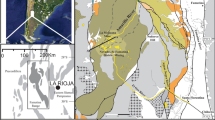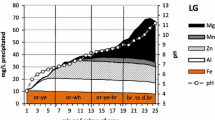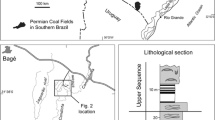Abstract
The North Appalachian Experimental Watershed in Coshocton, Ohio, USA has recorded average pH of precipitation of 4.7 over a 30-year period. The area lies within the Pennsylvanian siltstones and shale, dominated by aluminosilicates and <5% calcite. A study was conducted to determine the evolution of acid deposition through an unsaturated to saturated zone composed of siltstone and shale in an isolated hill, precluding lateral flow and seepage. The results from water–rock chemical reactions modeled using PHREEQM demonstrate the percolating precipitation water is neutralized to pH 7.5 within the top 1.5 m. The model suggests that, along with calcite, dissolution of albite, illite, and kaolinite are the dominant mechanisms of neutralization. The cation exchange capacity of the siltstone and shale, in the range 54.6–386 meq/100 g, appears to be a function of high organic carbon content of 2.0–3.2%. While cation exchange is responsible for some of the Na+ in solution, it is not the primary source of Ca2+, Mg2+, or K+ ions. Exchange onto clays is occurring, but is secondary to exchange on organic matter. Chemical composition of groundwater perched within a coal seam is controlled by oxidation and dissolution of pyrite, returning pH to approximately 4.0.
Résumé
Dans le bassin versant d’étude North Appalachian situé à Coshocton, Ohio, E.-U., les précipitations enregistrées au cours d’une période de 30 ans ont un pH moyen de 4.7. La zone d’étude est composée de siltstone et de shale d’âge Pennsylvanien, principalement composé d’alumino-silicates et <5% de calcite. Une étude a été entreprise afin de déterminer l’évolution des eaux acides à travers une zone allant de non-saturée à saturée, située dans une colline isolée principalement composée de siltstone et de shale, où l’écoulement latéral et les résurgences sont absents. Les réactions chimiques eau-roc ont été modélisées à l’aide de PHREEQM et les résultats démontrent que l’eau des précipitations qui percole est neutralisée à une valeur de pH de 7.5 et ce, dans les premiers 1.5 m. Le modèle suggère aussi que la dissolution de la calcite, de l’albite, de l’illite et de la kaolinite constitue le mécanisme dominant de neutralisation. La capacité d’échange cationique du siltstone et du shale, variant de 54.6 à 386 meq/100 g, semble être fonction du contenu élevé en carbone organique allant de 2.0 à 3.2%. Bien que l’échange cationique soit en partie responsable de la présence de Na+ en solution, il ne s’agit pas de la principale source de cations Ca2+, Mg2+ ou K+. L’échange sur les argiles est secondaire à l’échange sur la matière organique. La composition chimique de l’eau souterraine perchée dans un horizon de charbon est contrôlée par l’oxydation et la dissolution de la pyrite, réduisant ainsi le pH à une valeur d’environ 4.0.
Resumen
La Cuenca Experimental situada en los Apalaches del Norte, en Coshocton, Ohio, USA, ha recogido un pH medio en la precitación de 4.7 en un periodo de 30 años. El área se encuentra en las lutitas y pizarras, en las que dominan los aluminosilicatos y tienen <5% de calcita. El estudio se llevó a cabo para determinar la evolución de la deposición ácida a través de la zona no saturada y saturada, compuestas de lutitas y pizarras en un cerro aislado, excluyendo flujos laterales y filtraciones. Los resultados de las reacciones químicas roca-agua modeladas con el PHREEQM demuestran que las aguas infiltradas de la precipitación se neutralizan a pH 7.5 en los 1.5 m superficiales. El modelo sugiere que, conjuntamente con calcita, la disolución de albita, illita y caolinita son los mecanismos dominantes de neutralización. La capacidad de intercambio de cationes de las lutitas y pizarras, en el rango de 54.6–386 meq/100 g, parece estar en función del alto contenido en carbono orgánico, de 2.0–3.2%. Mientras que el intercambio de cationes es responsable de parte del Na+ en disolución, no constituye la fuente principal de los iones de Ca2+, Mg2+, ou K+. Se está produciendo intercambio entre arcillas, pero es secundario respecto al intercambio con materia orgánica. La composición química del agua subterránea colgada dentro de una veta de carbón está controlada por la oxidación y disolución de pirita, cambiando el pH a aproximadamente 4.0.















Similar content being viewed by others
References
Appelo CAJ, Postma D (1993) Geochemistry, groundwater and pollution. Balkema, Rotterdam, 536 pp
Appelo CAJ, Nienhuis PR, Willemsen A (1992) PHREEQM-PHREEQE in a mixing cell flowtube. In: Kharaka YK, Maest AS (eds) Water-rock interaction, vol 1. Balkema, Rotterdam, pp 201–212
ASTM (1995) ASTM D 2974-87 (1987) Standard test methods for moisture, ash, and organic matter of peat and other organic soils. American Society for Testing and Materials, West Conshohocken, PA
Bertsch PM, Layton WJ, Barnhisel RI (1986) The determination of specific forms of aluminum in natural waters. Soil Sci Am J 50:1449–1454
Blum JD, Gazis CA, Jacobson AD, Page Chamberlain C (1998) Carbonate versus silicate weathering in the Raikhot watershed within the High Himalayan Crystalline Series. Geology 26(5):411–414
Bricker OP (1986) Geochemical investigations of selected eastern United States watersheds affected by acid deposition. J Geol Soc Lond 143:621–626
Carroll D (1959) Ion exchange in clays and other minerals. Bull Geol Soc Am 70:749–780
Carroll D (1970) Clay minerals: a guide to their x-ray identification. Geol Soc Am Spec Pap 126:80
Caruccio FT (1975) Estimating the acid potential of coal mine refuse: the ecology of resource degradation and renewal. Blackwell, Oxford, pp 197–205
Caruccio FT, Geidel G (1986) An evaluation of mine waste-overburden analytical techniques. Proc. National Symp. on Mining Hydrology, Sedimentology and Remediation. Univ. of Kentucky, USA, December, 1986, pp 147-153
Chapman HD (1965) Cation exchange capacity. In: Black CA (ed) Methods of soil analysis, Part 2, Monogr. Ser., vol 9. American Society of Agronomy, Madison, WI, USA, pp 891–900
Cosby BJ, Hornberger GM, Galloway JN, Wright RF (1985a) Time scales of catchment acidification. Environ Sci Technol 19:1144–1149
Cosby BJ, Wright RF, Hornberger GM, Galloway JN (1985b) Modeling the effects of acid deposition: estimation of long-term water quality responses in a small forested catchment. Water Resour Res 21:1591–1601
Deines P, Langmuir D, Harmon RS (1974) Stable carbon isotope ratios and the existence of gas phase in the evolution of carbonate groundwaters. Geochim Cosmochim Acta 38:1147–1164
Drever JI (1988) The geochemistry of natural waters. Prentice-Hall, Engelwood Cliffs, NJ, 437 pp
Driscoll CT (1980) Aqueous speciation of aluminum in the Adirondack Region of New York State, USA. In: Drablos D, Tollan A (eds) Ecological impacts of acid precipitation. Proceedings of an international conference, Sandefjord, Norway, March, 1980, pp 214–215
Driscoll CT (1984) A procedure for the fractionation of aqueous aluminum in dilute acidic waters. Intern J Environ Anal Chem 16:167–283
Ferm JC (1970) Allegheny deltaic deposits. In: Morgan JP (ed) Deltaic sedimentation, modern and ancient. Soc Econ Paleontol Mineralog Spec Publ 15:246–255
Fetter CW (1993) Contaminant hydrogeology. Macmillan, New York, 458 pp
Flores RM (1967) Relationship of geometry to the origin of the Lower Freeport Sandstone (middle Allegheny) of eastern Ohio. J Sediment Petrol 37:624–632
Gabet R (1993) The role of aluminosilicate and cation exchange reactions in groundwater evolution, Geauga County, Ohio. MSc Thesis, Kent State University, Kent, OH 136 pp
Garrels RM, Christ CL (1965) Solutions, minerals and equilibria. Freeman, Cooper, San Francisco, 450 pp
Grim RE (1968) Clay mineralogy. McGraw-Hill, New York, 596 pp
Hathaway JC, Carroll D (1954) Distribution of clay minerals and ion-exchange capacity in some sedimentary materials. In: Swineford A, Plummer LN (eds) Clays and clay minerals. National Academy of Sciences, Printing and Publishing Office, Washington, DC, pp 171–182
Hem JD (1968) Graphical methods for studies of aqueous aluminum hydroxide, fluoride and sulfate complexes. US Geol Surv Water Suppl Pap 1827-B:33
Hem JD (1985) Study and interpretation of the chemical characteristics of natural water. US Geol Surv Water Suppl Pap 2254:263
Hemond HF, Fechner EJ (1994) Chemical fate and transport in the environment. Academic Press, New York, 338 pp
Hillel D (1980) Applications of soil physics. Academic Press, New York, 385 pp
Johnson NM (1984) Acid rain neutralization by geological materials. In: Bricker OP (ed) Geological aspects of acid deposition. Acid precipitation series, no. 7. Butterworth, Boston, MA, pp 37–53
Joslin JD, Wolfe MH (1989) Aluminum effects on Northern Red Oak seedling growth in six forest soil horizons. Soil Sci Soc Am J 53:247–281
Katz BG, Bricker OP, Kennedy MM (1985)Geochemical mass-balance relationship for selected ions in precipitation and stream water, Catoctin Mountains, Maryland. Am J Sci 285:931–962
Lamborn RE (1954) Geology of Coshocton County. Ohio Div Geol Surv Bull 53:1–245
Lewis VE (1996) Modeling the chemical evolution of acid deposition through the unsaturated zone of Urban’s Knob at the USDA ARS near Coshocton, Ohio. MSc Thesis, Kent State University, Kent, OH, 224 pp
Likens GE, Borman FH, Pierce RS, Eaton JS, Johnson NM (1977) Biogeochemistry of a forested ecosystem. Springer, New York, 146 pp
Marshall TL, Holmes JW (1988) Soil physics. Cambridge University Press, Cambridge, 374 pp
Morel FMM (1983) Principles of aquatic chemistry. Wiley, New York, 446 pp
Mulder J, van Breemen, Eijck HC (1989) Depletion of soil aluminum by acid deposition and implications for acid neutralization. Nature 337:247–249
Parkhurst DL, Thorstenson DC, Plummer LN (1980) PHREEQE: a computer program for geochemical calculations. US Geol Surv Water Res Invest Rep 80–96:210
Pavan MA, Bingham FT (1982) Toxicity of aluminum to coffee seedlings grown in nutrient solution. Soil Sci Soc Am J 46:993–997
Potter WD, Baker MV (1938) Some of the factors affecting the behavior of perched water tables at the North Appalachian Experimental Watershed near Coshocton, Ohio. Trans Am Geophys Union 1938:393–402
Reuss JO (1983) Implications of the calcium-aluminum exchange system for the effect of acid precipitation on soils. J Environ Qual 12:591–595
Reuss JO, Johnson DW (1985) Effect of soil processes on the acidification of water by acid deposition. J Environ Qual 14:26–31
Schuh WM, Klinkebiel DL, Gardner JC (1993) Use of an integrated transient flow and water budget procedure to predict partition components of local recharge. J Hydrol 148:27–60
Singer P, Stumm W (1969) Acid mine drainage: the rate determining step. Science 167:1121–1123
Stumm W, Morgan JJ (1981) Aqueous chemistry. Wiley, New York, 780 pp
USEPA (US Environmental Protection Agency) (1979) Methods for chemical analysis of water and wastes. EPA-600/4-79-020, USEPA, Cincinnati, OH
US Geological Survey (1977) National handbook of recommended methods for water-data acquisition. US Geological Survey, Reston, VA
US Geological Survey (1982) Techniques of water resources investigations of the United States geological survey: quality assurance practices for the chemical and biological analysis of water and fluvial sediments, Book 5, Chapt. A6. US Geological Survey, Reston, VA, 181 pp
USDA (1975) Soils of the North Appalachian Experimental Watershed. USDA Misc. Publ. 1296, USDA, Washington, DC, 145 pp
Urban JB (1965) Geologic and hydrologic significance of springs and seeps in eastern Ohio. J Soil Water Conserv 20:178–179
Acknowledgements
The authors are indebted to Dr. Peter S. Dahl of Kent State University for his constructive criticism of the initial draft of this paper and many helpful suggestions, as well as to three anonymous reviewers for their helpful comments and suggestions.
Author information
Authors and Affiliations
Corresponding author
Rights and permissions
About this article
Cite this article
Eckstein, Y., Lewis, V.E. & Bonta, J.V. Chemical evolution of acid precipitation in the unsaturated zone of the Pennsylvanian siltstones and shale of central Ohio. Hydrogeol J 15, 1489–1505 (2007). https://doi.org/10.1007/s10040-007-0199-4
Received:
Accepted:
Published:
Issue Date:
DOI: https://doi.org/10.1007/s10040-007-0199-4




